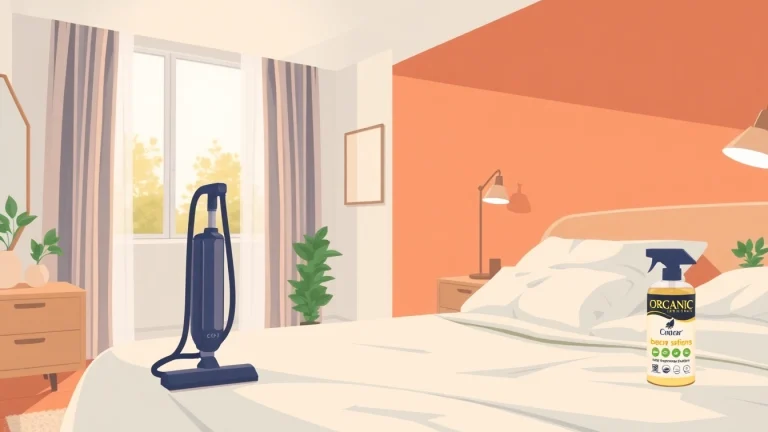
Simple and Effective Bed Bug Control Techniques to Ensure a Peaceful Night’s Sleep
Understanding Bed Bugs: What You Need to Know
Bed bugs, tiny insects that feed on the blood of humans and animals, have become increasingly prevalent in urban settings, often hitchhiking their way into homes through luggage, clothing, and used furniture. An understanding of bed bugs, their behavior, and the risks they pose is essential for effective bed bug control. This article delves into the life cycle of these pests, the signs of their presence, and the health risks associated with infestations.
Life Cycle and Habits of Bed Bugs
Bed bugs go through several stages in their life cycle: egg, nymph, and adult. A female bed bug can lay up to 500 eggs in her lifetime, typically in hidden crevices and cracks near sleeping areas. The eggs hatch within a week, leading to nymphs that resemble miniature adults. These nymphs must feed on blood to mature, and after several molts, they reach adulthood within one to two months.
Understanding their habits is crucial for controlling their populations. Bed bugs are nocturnal and prefer to hide during the day in areas close to their food sources, making proper inspection and treatment vital. Common hiding spots include mattresses, box springs, bed frames, and the cracks and crevices of walls and furniture.
Signs of Bed Bug Infestation
Identifying a bed bug infestation early can significantly reduce the efforts required for eradication. Common signs include:
- Small, dark spots on sheets or surfaces, which are bed bug droppings.
- Faded blood stains on bed linens from crushed bed bugs.
- Visible bed bugs themselves, often found in the seams and crevices of mattresses and furniture.
- A musty odor derived from the scent glands of bed bugs.
Health Risks Associated with Bed Bugs
While bed bugs are not known to transmit diseases, their bites can lead to significant discomfort and secondary skin infections. Many people experience allergic reactions to bed bug saliva, resulting in itchy welts, which can amplify anxiety and sleeplessness. Dealing with this pest can thus affect not only physical health but also mental well-being.
Proven Bed Bug Control Strategies
Effective bed bug control requires a comprehensive approach that includes non-chemical methods and, where necessary, the use of insecticides. Below are various strategies to combat these resilient pests.
Non-Chemical Treatment Methods
Non-chemical methods should be the first line of defense against bed bugs, especially in the early stages of infestation. Here are some effective strategies:
- Heat Treatment: Bed bugs cannot survive temperatures above 113°F (45°C). Professional pest control services often use heat treatment to raise the temperature in infested areas, effectively killing all life stages of bed bugs.
- Cold Treatment: Conversely, temperatures below 32°F (0°C) can also eliminate bed bugs. Placing infested items in the freezer for at least four days can be an effective method of control.
- Vacuuming: Regularly vacuuming can significantly reduce bed bug numbers. Focus on areas where bed bugs are likely to hide, such as seams and crevices in mattresses and furniture. Remember to dispose of the vacuum bag immediately after use.
Chemical Solutions: What Works?
While non-chemical methods are effective, chemical treatments may be necessary for severe infestations. Consider the following options:
- Insecticidal Spray: Various pesticides are available to treat bed bugs effectively. Always select products approved by the Environmental Protection Agency (EPA) and follow the manufacturer’s instructions carefully for safe and effective application.
- Insect Growth Regulators (IGRs): These chemicals disrupt the bed bug life cycle, preventing nymphs from maturing into adults, thereby reducing the population over time. Using IGRs in combination with sprays can enhance effectiveness.
DIY Bed Bug Control Tips and Tricks
For those seeking to tackle bed bugs independently, several do-it-yourself methods can be employed:
- Steam Treatment: Steam cleaners can be effective at killing bed bugs on contact. Ensure the steam temperature reaches at least 130°F (54°C) for best results.
- Essential Oils: While not a primary solution, some essential oils like tea tree and lavender can repel bed bugs. However, their effectiveness varies, and they should not be solely relied upon.
- Encasements: Use mattress and pillow encasements that are specifically designed to trap bed bugs. This can prevent new infestations and protect existing mattresses from becoming infested.
Preparing Your Home for Bed Bug Treatment
Before initiating treatment, preparing your home is crucial to maximize the effectiveness of the chosen control methods. Below are essential preparation steps to follow.
Decluttering and Cleaning Areas Affected by Bed Bugs
A cluttered environment provides hiding spots for bed bugs, making control efforts less effective. Begin by decluttering your home, focusing on areas surrounding the bed. Store items in plastic bins to minimize potential hiding spots, and consider donating items that cannot be adequately cleaned.
Sealing Mattresses and Furniture
Encasing mattresses and box springs is critical in preventing bed bugs from accessing these areas. Consider using bed bug-proof encasements to trap bugs already present and prevent new infestations. Ensure that any furniture, such as couches or chairs, are also treated or encased appropriately.
Creating a Safe Environment During Treatment
During treatment, it’s essential to create a safe environment for yourself and your family. Cover any food items and ensure pets are kept away from treated areas. Follow all safety instructions for any chemicals or heat treatments being used.
Aftercare: Keeping Bed Bugs Away
Even after treatment, monitoring and maintaining a bed bug-free environment is crucial to preventing reinfestation. The following strategies can be instrumental in this ongoing process.
Monitoring for Reinfestation
After treatment, regularly inspect your home for signs of bed bugs. Use bed bug monitors and traps to help detect any returning pests early. Inspect your home periodically, particularly in areas close to sleeping spaces.
Ongoing Prevention Techniques
Implementing ongoing prevention measures is vital in maintaining a bed bug-free home. Here are some effective strategies:
- Regular Cleaning: Keep your home tidy and vacuum frequently to decrease the likelihood of a reinfestation.
- Be Cautious with Used Items: Inspect second-hand furniture and clothing before bringing them into your home to reduce the risk of introducing bed bugs.
- Travel Smart: When traveling, inspect hotel rooms and keep luggage elevated off the floor to avoid contact with potential bed bug habitats.
Resources for Professional Help
For persistent infestations, seek assistance from professional pest control services. They possess specialized knowledge and tools to address severe infestations effectively. Research local exterminators to find one with good reviews and a proven track record in bed bug control.
Common Myths About Bed Bugs and Their Control
Misconceptions about bed bugs can lead to ineffective treatment and unnecessary stress. Let’s address some common myths surrounding these pests.
Mistaken Beliefs That Lead to Ineffective Treatment
A common myth is that bed bugs are only found in unsanitary conditions. In reality, these pests can infest even the cleanest homes. Their presence is more about proximity to a food source (i.e., humans) than cleanliness.
Correcting Misconceptions About Pest Control Products
Many believe that over-the-counter treatments are sufficient for managing bed bug infestations. While some products can help, professional guidance is often required for elimination, especially in larger infestations. Misuse of products can also exacerbate the problem.
Understanding the Limitations of DIY Solutions
While DIY solutions are helpful, they generally are not a complete replacement for professional treatment. Many homeowners underestimate the persistence of bed bugs, and without thorough, persistent intervention, infestations often recur.


